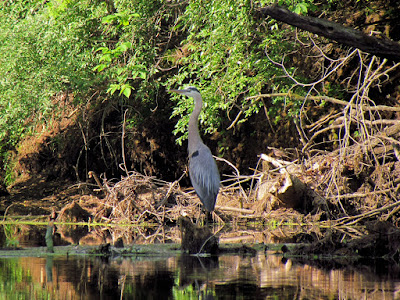I argued against having a house cleaner, but I did not express myself as well as possible. My argument probably was taken as one focusing on need and money. But, in actuality, my six foot one inch frame was feeling threatened by the idea of a stranger in the house. So, a thing of sentimental value has been stolen. Fortunately, it is just a thing, and the most important things in life are not things. If only we were birds....
The birds in the east marsh are all about threat right now. Nests are built and eggs are laid. It's three to four weeks of sitting, tending, and guarding. After that, it is several more of watching, herding and in some cases, feeding. One false move and the family is kapute.
 |
| seaside sparrow |
I'm in the East River before 7am and paddling against the beginning of the ebb, the day calm, the sky clear and the temperatur still cool. I will head up the Neck River to Bailey Creek and through the Sneak back into the East.
There is an osprey nest built on a low dock that has become detached from land. When I paddle past it, the osprey circles over me, always with its head turned right at me until I begin to leave its territory. You do not need to be a mind reader to understand the osprey.
My head is well above the spartina grass and I am in plain view to all that live there. The glossy ibises are out in the center a few hundred yards from the water's edge. They are feeding in the shallow ponds that form briefly at high tide. They seem reluctant to come to the river bank or mud flats once they start nesting. They seem to stay where they can see an approaching predator from a long distance.
The willets leave no question when I get near their nests. They have a piercing warning cry and they use it to alert every willet in the area that danger is present. The nests must be on the ground now because once they are airborne, they will chase everything from a sparrow to an osprey. When I'm in the Sneak, it is clear that I'm near nests because several of them call alert at the same time. I've always wanted to see a willet nest, but I can't bear to cause that much disturbance just to satisfy my own curiosity. I paddle on.
 |
| at the saw mill dam |
|
I turn back at the tumbled saw mill dam, a mile short of my usual point. I cannot keep my head and heart in the game for more than a few minutes at a time.
It is odd to think that sometimes it is easier to understand a bird than another person.













































